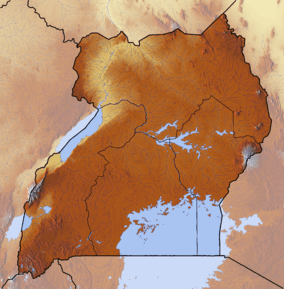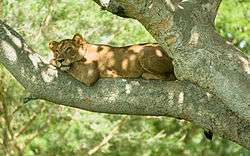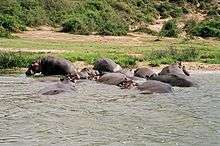Queen Elizabeth National Park
Queen Elizabeth National Park is a national park in Uganda.[1]
| Queen Elizabeth National Park | |
|---|---|
IUCN category II (national park) | |
Crater Lake | |
 Location of Queen Elizabeth National Park | |
| Location | |
| Nearest city | Kasese |
| Coordinates | 00°08′14″S 30°02′28″E |
| Area | 1,978 km2 (764 sq mi) |
| Established | 1952 |
| Governing body | Ugandan Wildlife Authority |
Location
QENP is in the Western Region of Uganda, spanning the districts of Kasese, Kamwenge, Rubirizi, and Rukungiri. The park is approximately 400 kilometres (250 mi) by road south-west of Kampala, Uganda's capital and largest city.[2] The town of Kasese is just outside the northeastern edge of the park, while the town of Rubirizi is just outside the park's southeastern boundaries.[3] The park includes the Maramagambo Forest and borders the Kigezi Game Reserve, the Kyambura Game Reserve, and the Kibale National Park in Uganda, and the Virunga National Park in the Democratic Republic of the Congo.[3]
History
The park was founded in 1952 as Kazinga National Park. It was renamed two years later to commemorate a visit by Queen Elizabeth II.[4]
Overview


Queen Elizabeth National Park occupies an estimated 1,978 square kilometres (764 sq mi).[5] The park extends from Lake George in the north-east to Lake Edward in the south-west and includes the Kazinga Channel connecting the two lakes.[3]
Queen Elizabeth National Park is known for its wildlife, including African buffalo, Ugandan kob, hippopotamus, giant forest hog, warthog, Nile crocodile, African bush elephant, African leopard, lion, and chimpanzee. It is home to 95 mammal species and over 500 bird species. The area around Ishasha in Rukungiri District is famous for its tree-climbing lions, whose males sport black manes.[6] Poachers killed six elephants in the park in 2015, triggering both anger and frustration within the Ugandan conservation community.[7]
Queen Elizabeth National Park together with the adjacent Virunga National Park is a Lion Conservation Unit.[8] The area is considered a potential lion stronghold in Central Africa, if poaching is curbed and prey species recover.[9]
The park is also famous for its volcanic features, including volcanic cones and deep craters, many with crater lakes, such as the Katwe craters, from which salt is extracted.[10][11]
Services in the park include a telecenter run by Conservation Through Public Health and the Uganda Wildlife Authority, neighboring the Queen's Pavilion, park lodges, game and scenic drives, and boat launches.[12]
Twinning
QENP and the Queen Elizabeth Country Park in England are twinned in a project of "cultural exchange, mutual support and has its main emphasis on supporting Conservation through working closely with and empowering local communities".[13]
See also
References
- QENP (29 October 2016). "Queen Elizabeth National Park: Ishasha Sector". Mweya: Queen Elizabeth National Park (QENP). Retrieved 29 October 2016.
- Globefeed.com (29 October 2016). "Distance between Kampala Road, Kampala, Uganda and Mweya, Western Region, Uganda". Globefeed.com. Retrieved 29 October 2016.
- Google (29 October 2016). "Map of Queen Elizabeth National Park" (Map). Google Maps. Google. Retrieved 29 October 2016.
- UWA (2016). "Queen Elizabeth National Park: History". Kampala: Uganda Wildlife Authority (UWA). Retrieved 29 October 2016.
- UWA (29 October 2016). "Queen Elizabeth National Park: Geography and Climate". Kampala: Uganda Wildlife Authority (UWA). Retrieved 29 October 2016.
- QENP (2016). "The tree climbing lions of Queen Elizabeth National Park in Uganda". Mweya: Queen Elizabeth National Park Uganda (QENP). Retrieved 29 October 2016.
- Musoke, Ronald (11 January 2016). "Uganda: Queen Elizabeth Park Elephant Deaths". The Independent (Uganda) via AllAfrica.com. Kampala. Retrieved 29 October 2016.
- IUCN Cat Specialist Group (2006). Conservation Strategy for the Lion Panthera leo in Eastern and Southern Africa. Pretoria, South Africa: IUCN.
- Treves, A., Plumptre, A. J., Hunter, L. T., & Ziwa, J. (2009). "Identifying a potential lion Panthera leo stronghold in Queen Elizabeth National Park, Uganda, and Parc National Des Virunga, Democratic Republic of Congo". Oryx. 43 (1): 60–66. doi:10.1017/s003060530700124x.CS1 maint: uses authors parameter (link)
- MSL (2016). "Mweya Safari Lodge: Katwe Explosion Crater". Mweya: Mweya Safari Lodge (MSL). Retrieved 29 October 2016.
- QENP (2016). "Queen Elizabeth National Park: Lake Kwatwe Explosion Crater". Queen Elizabeth National Park (QENP). Retrieved 29 October 2016.
- CTPH (2016). "Welcome to CTPH: CTPH achieves biodiversity conservation by enabling people, wildlife and livestock to coexist through improving their quality of life in and around Africa's protected areas". Conservation Through Public Health. Retrieved 29 October 2016.
- QECPUK (29 October 2016). "Welcome to The Queen Elizabeth Parks Twinning Project". Queen Elizabeth Country Park United Kingdom (QECPUK). Retrieved 29 October 2016.
External links
- BirdLife International. "Important Bird Areas factsheet: Queen Elizabeth National Park and Lake George".
- QENP Map Uganda Dept of Lands and Surveys, 1961
- Queen Elizabeth National Park Official Tourism Website of Queen Elizabeth National Park.